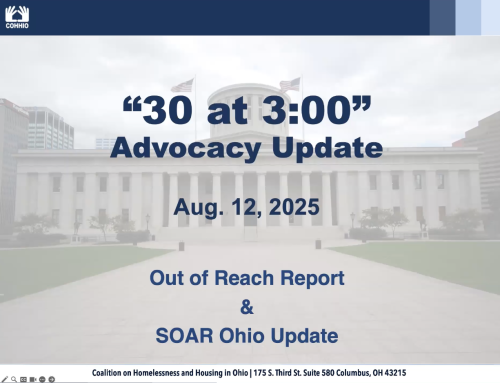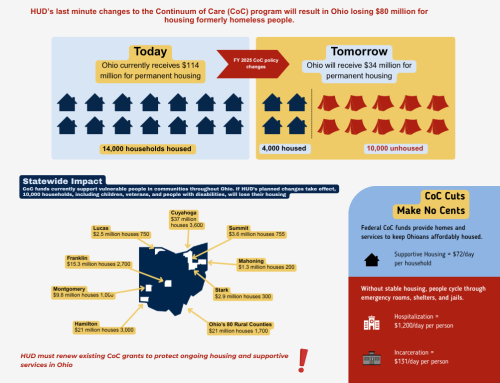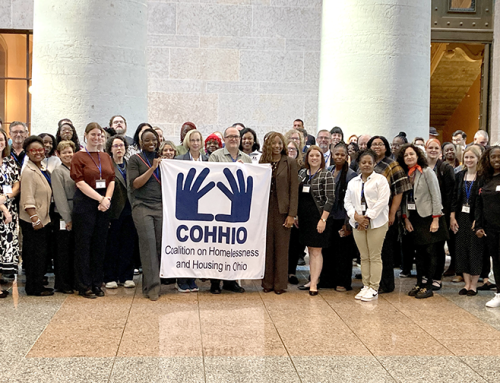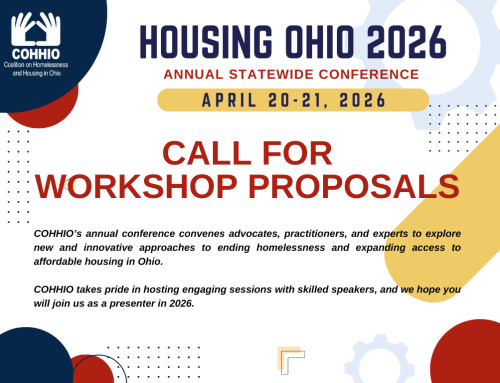HUD recently released its annual report to Congress that shows the national homelessness rate increased by a whopping 18% in one year. Here in Ohio, the increase was only 3%. While that’s very concerning, it indicates that Ohio is well positioned to reverse the trend.
Rent inflation in Ohio has been even worse than much of the country in recent years, but the cost of living is still relatively low compared to the coastal states where homelessness is exploding. The homeless populations of California and New York combined make up 45% of all 771,480 people experiencing homelessness in the U.S. It’s no coincidence that cities in California and New York also have the highest rents in the U.S.
Fortunately, Ohio is also blessed with many effective local nonprofits using evidence-based strategies to prevent homelessness, quickly rehouse people, and provide services to keep them stably housed. But their efforts are hindered by the lack of affordable homes and funding for those services.
That’s why COHHIO and our allies in the Home Matters to Ohio coalition recently unveiled a housing policy platform for the State to start increasing the supply of affordable housing. Proposals include things like strengthening the Ohio Housing Trust Fund, expanding the new Ohio Low Income Tax Credit program, increasing protections for at-risk renters, and zoning reform.
Gov. DeWine will be releasing his next two-year budget proposal within the next month, and then the legislature needs to amend and pass it by June 30. We will be working alongside the Home Matters coalition to make sure the final budget includes achievable measures to address Ohio’s affordable housing crisis, and we’ll keep you informed.
In Washington, President-elect Trump’s next administration is taking shape with Scott Turner nominated to be the next HUD secretary. Turner reportedly voted against legislation to expand affordable housing and fund homeless services when he was a Texas state legislator.
Newly elected Sen. Bernie Moreno (R-OH) got a seat on the Senate Banking, Housing and Urban Affairs Committee that was chaired by former Sen. Sherrod Brown (D-OH), whom Moreno defeated in the November election. Sen. Brown was a huge champion of affordable housing, and we will miss him. But we look forward to working with Sen. Moreno to help him fill those big shoes.
Congress will have to act quickly to keep the government funded, pass an FY 2025 spending bill, and raise the debt ceiling. The budget reconciliation bill the new Republican majority is expected to pass could include cuts to federal housing and homelessness programs.
There’s a lot of change and uncertainty heading into this new year, but COHHIO will let you know when the time is right to speak out for the funding and policies necessary to move the needle back to the right direction – more housing, less homelessness. And here are four things you can do right now to prepare for what’s to come in 2025:
- Get your organization to endorse the Home Matters to Ohio policy platform to build momentum for including affordable housing in the next state budget;
- Reach out to your members of Congress and the Statehouse to let them know that housing and homelessness programs are essential to building a strong foundation for your community to thrive! Check out our website for legislative directories and download our Advocacy Guide. And feel free to reach out to our Advocacy Director Gina Wilt with any questions;
- Submit public comment opposing bureaucratic work requirements that will strip Medicaid coverage from tens or even hundreds of thousands of Ohioans (the deadline is Jan. 21!)
- Join COHHIO if you or your organization are not already a member. Your membership dues support our advocacy program!
Thanks for supporting the fight for a safe, decent, affordable home for all Ohioans!
Amy Riegel
Executive Director
Business, community coalition proposes big action on Ohio housing laws
(Statehouse News Bureau) A coalition of two dozen business and community organizations who want to see housing policies become bigger priorities rolled out their pitch to the legislature in December. The Ohio Chamber of Commerce, Coalition on Homelessness and Housing in Ohio, and Habitat for Humanity, among others, collaborated on Home Matters to Ohio. The plan includes 11 legislative proposals… Leah Evans, president and CEO of affordable housing provider Homeport, is part of Home Matters to Ohio. Without action on a housing agenda, Evans said more Ohioans will become at-risk for housing struggles. “We maybe historically have thought of those at the lowest end of the income spectrum as those that are the most vulnerable,” Evans said in a December interview. “We see that moving up more and more into the middle-income spectrum, so I think what we’re seeing is that more people are impacted by housing scarcity, whether that’s rural or even urban or suburban contexts.”
Trump wants to address homelessness by working with states to ban street camping
(NPR) President-elect Donald Trump has said he will overhaul the way the country manages homelessness. That’s right as the number of homeless people across the U.S. has reached its highest point since records have been kept… Trump said he’ll work with states to ban urban camping wherever possible and push people into treatment for drug addiction and mental health.
Ohio’s proposed Medicaid work requirement could cost thousands of Ohioans their healthcare coverage
(Center for Community Solutions) Unless they qualify for an exemption, up to 450,000 Ohioans could be at risk of losing health coverage if Ohio’s proposed Medicaid work requirement waiver goes into effect. This estimate was calculated by The Center for Community Solutions based on the latest publicly available data on the employment status and health coverage of Ohioans. It far exceeds the fewer than 62,000 Ohioans who the Ohio Department of Medicaid (ODM) projects would lose coverage if the proposed waiver were implemented.
A slew of new housing laws take effect this month to streamline building, protect tenants
(Ohio Capital Journal) The new laws include measures to combat landlord retaliation in Illinois and Minnesota, to seal eviction records in Idaho and, in California, to streamline the process for building backyard accessory dwelling units, known as ADUs. Other states focused on the barriers preventing housing from being built by relaxing zoning laws to allow for new types of development, and put the onus on cities to make affordable housing available… “I expect that it will be a banner year for housing legislation, because many state legislators and governors ran for the first time on a platform that included addressing housing cost inflation,” said economist Salim Furth, a senior research fellow and director of the urbanity project at the Mercatus Center at George Mason University. “Now they need to deliver.”
Homeless camp sweeps impact the unhoused
(Spectrum News) COLUMBUS – Ben Sears is the executive director of the Columbus Coalition for the Homeless. He said homeless camp sweeps have been happening for years. “This is not a solution solving homelessness. It’s not a solution that’s helping individuals living in the camps,” said Sears. “This process has been going on for quite a long time. And throughout the year, many camps get cleared.” After the homeless camps are swept, Sears said many unhoused persons that were living in the camp just move their belongings down the road, creating a never-ending cycle.
Low temps highlight faults of crowded, chaotic men’s shelter: Some call for new approach to homelessness
(Dayton Daily News) The operator of the Gettysburg Gateway Shelter for Men and some men staying there agree the shelter is in a terrible location, too far from supportive services, and the conditions inside are crowded and chaotic. St. Vincent De Paul Society, Dayton says they plan to cease operations there and is calling for a new approach to addressing local homelessness. But as one of the largest and busiest men’s shelters in the state, the Gettysburg facility provides lifesaving warmth and housing to hundreds of men who have nowhere else to go.
BG Call to Action focuses on filling gaps in tenant rights, housing, transportation and climate resiliency
(BG Independent News) BOWLING GREEN – Rose Drain, a member of BG SONG and the Call to Action movement, said citizen teams are looking to partner with other groups with shared interests. One of the priorities of the teams is to work with people who rent their homes in Bowling Green – and form a group that will stand up for renters’ rights. That will include connecting with BGSU Undergraduate Student Government, and with year-round residents who rent their homes.
Alliance Citizens for Safe Housing supports rental registration in Alliance
(Canton Repository) For a year, a group of landlords has fought back against a rental registration proposal that remains a concept. There has been no progress in the bid to draft legislation. However, the fight has accomplished something over 12 months. It birthed an opposition that backs the registrations. It all started last summer.
With no seasonal shelters, Cleveland homeless population struggles to find warm places to sleep
(News 5) Josiah Quarles, the director of organizing and advocacy for the Northeast Ohio Coalition for the Homeless, says that during this time of year, shelters see more people looking for beds, but they don’t have enough. That’s where seasonal shelters come in to help with the demand. “Seasonal shelters are like smaller shelters that open up primarily during the winter season to provide people with shelters, and they provide alternatives for folks who may have had [a] bad experience, traumatic experiences at the larger shelters,” Josiah said. Last year, they saw four seasonal shelters, but this year there are none. “Yeah, I think it’s a failure on all fronts, right? It’s a governmental failure, a service provider failure, a community failure,” Josiah said.
‘A safe haven’: Homeless Cincinnatians seek shelter from cold at converted rec center
(Cincinnati Enquirer) The Over-the-Rhine Emergency Warming Shelter echoed with chatter Tuesday afternoon as people gathered inside to escape the biggest snowstorm Cincinnati has seen in years… This was the second day the warming center opened to those who are cold and without housing. The city spent six months planning for emergency weather like this, and it paid off. About 200 people came through the center’s doors on Monday, and organizers expected more to arrive in coming days as temperatures drop into single digits.
Lucas County homelessness increasing due to several factors; residents encouraged to speak up
(WTOL) Embree said TLCHB believes the total homeless population has increased by 10% in the last year, meaning at least 130 people have become homeless in the last 365 days. But why are we seeing this spike? Embree said inflation and the price of housing are major factors. “You need to be able to make close to $18 an hour as a single to be able to affordably have housing, which is estimated. And many opportunities are not paying that,” she said. Also, safety nets that used to be available to the public and helped people pay for rent, utilities and even mortgage assistance ended after the pandemic.
Toledo seeks public input for allotment of millions of dollars in city programs
(WTOL) The city of Toledo is actively seeking public input to guide an investment of millions of dollars in housing, homelessness and community development programs. In a series of interactive community meetings held by the city, residents are encouraged to share their ideas and concerns. “We need to put everybody’s ideas out there,” said Eduardo Adams, a resident of the Southside neighborhood and advocate against youth violence. “We have a problem with housing and there’s not enough jobs.”
Organization anticipates increase in Franklin County’s unsheltered homeless population in count
(WOSU) Steve Skovensky, Chief Program Effectiveness Officer for Community Shelter Board, says the organization is expecting an increase in this year’s count. “We are in the middle of what could be a projected 68% increase in unsheltered homelessness,” Skovenksy said. “That’s due to the lack of affordable housing options, it’s due to all those external factors.” One demographic that Skovensky says is seeing an increase in homelessness are senior citizens.
Homelessness crisis in Seneca County
(The Courier) After it was announced that the Sisters of St. Francis had decided to close the St. Francis Spirituality Center, it was later announced in late November of 2024 that a partnership between St. Francis and New Housing Ohio had occurred and a shelter for the area unhoused would be built on the St. Francis campus starting in July 2025… “Until Seneca County acquires more affordable housing units there will continue to be a significant homeless crisis… We also need additional emergency rental assistance to be able to keep those that are housed in their own homes placed,” Briihl said.
Ohio cities want more housing options. Could the solution be in their backyards?
(The Ohio Newsroom) This year, Columbus launched a pilot program to explore the value of accessory dwelling units, or ADUS: small, independent dwellings that sit on the same lot as a single family home. Dayton is also considering relaxing its zoning codes to encourage more ADUs within the city. Mount Vernon, a small community in central Ohio, even passed an emergency ordinance to allow the construction of the so-called in-law suites amid its housing shortage. The small city of Cleveland Heights is encouraging the use of ADUs through a design competition.
Cleveland ministry files appeal after judge blocks construction of youth drop-in center in Ohio City
(WKYC) While Lutheran Metropolitan Ministry aims to close a gap on unmet needs, a Cuyahoga County judge has rejected the project for zoning reasons. On Tuesday, LLM held a press conference with their project partners to discuss their grievances… “Young people should not receive services in impoverished or industrial sites,” Foschia said. “They deserve to be in a diverse neighborhood with all types of people and services so they can thrive. They seek safety, resources, and a sense of belonging, just like you and I. We know this is the right place to provide a safe, supportive environment for youth and offer them stability, self-determination, and hope.”
Fair Housing surveying Cuyahoga County residents, landlords about renting with criminal histories
(Cleveland.com) The Fair Housing Center for Rights and Research wants to hear from Cuyahoga County residents with prior criminal convictions about how they’re finding housing. The nonprofit, which works to eliminate housing discrimination, is conducting a 12-question survey through Jan. 20 to “gather the opinions and experiences of people with prior criminal convictions living in Cuyahoga County,” according to a summary on the survey website… Fair Housing Senior Research Associate Austin Cummings said he hopes it will inform better policy to reverse housing segregation, which can impact an individual’s access to healthcare, employment, safe neighborhoods and stability.
Franklin County evictions hit another all-time high in 2024
(WSYX) Evictions in Franklin County jumped by 40 percent since pre-pandemic levels in 2024, according to the national database Eviction Lab, that tracks evictions across the county… “We’ve got work to do,” Ohio Sen. Hearcel Craig, D-Columbus, told ABC6 News last month. “I’m not looking for excuses at this point.” Craig reached across the aisle to create Senate Bill 245 last legislative session with Sen. Michele Reynolds, R-Canal Winchester. The bill provided free legal counsel for evicted tenants, created a legal defense fund and automatically sealed eviction cases after seven years.








